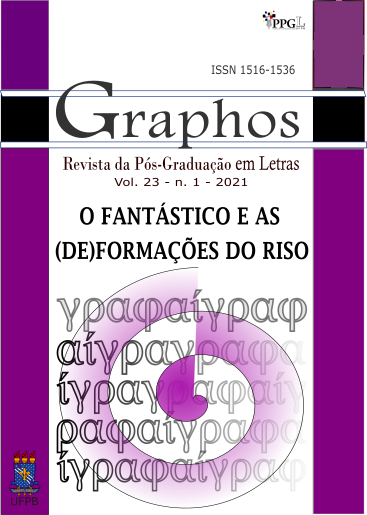Death is serious even when it makes you laugh: José Saramago’s disconcerting laughter
DOI:
https://doi.org/10.22478/ufpb.1516-1536.2021v23n1.57694Keywords:
Saramago, Laughter, Irony, Humor, FantasticAbstract
Known for novels that deal with serious and uplifting themes, José Saramago, in his last phase of novel production, presents us with a humorous face, which comprises the last three novels published in his lifetime. In this article, we seek to read the first of this triad, As intermitências da morte (2005), in which is presented an unusual universe since the strike of a death-character that claims his rights to be noticed. A serious matter par excellence, it is worked through humour, and causes a disconcerting laugh in the reader, impelling him to reflect on his own condition as a human being. Based on the studies of Hutcheon (1985), Duarte (2006), Propp (1992), D'Angelli and Paduano (2007), Alberti (1999), Minois (2003) and Roas (2014), it is possible to observe how the narrative transcends reality, subverting it through laugh, parody and irony, as well as by resorting to the fantastic. These elements are responsible for motivating a new reflection on the topic of death. The disconcerting laugh in this novel acts as an indication that we need to review our way of seeing death and transform ourselves from this reflection. It is possible to infer that, through the fantastic, Saramago stimulates the intellectual and ethical development of the subject and demands boldness to transcend the old and find a new meaning for death.
Downloads
References
ALAVARCE, Camila da Silva. A ironia e suas refrações: um estudo sobre a dissonância na paródia e no riso. São Paulo: Editora UNESP, 2009. Disponível em: < https://repositorio.unesp.br/bitstream/handle/11449/109119/ISBN9788579830259.pdf?sequence=2&isAllowed=y>. Acesso em: 26 maio 2021.
ALBERTI, Verena. O riso e o risível: na história do pensamento. Rio de Janeiro: Jorge Zahar Ed. FGV, 1999.
CAMPRA, Rosalba. Lo fantástico: una isotopía de la transgresión. In: ROAS, David (org.). Teorías de lo fantástico. Madrid: Arco/Libros, 2001.
CESERANI, Remo. O fantástico. Tradução de Nilton Cezar Tridapalli. Curitiba: UFPR, 2006.
D’ANGELI, Concetta; PADUANO, Guido. O cômico. Tradução de Caetano Waldrigues Galindo. Curitiba: Ed. UFPR, 2007.
DUARTE, Lélia Parreira Duarte. Ironia e humor na literatura. Belo Horizonte: PUC Minas; São Paulo: Alameda, 2006.
HUTCHEON, Linda. Uma teoria da Paródia. Tradução de Tereza Louro Pérez. Lisboa: Edições 70, 1985.
MINOIS, Georges. História do riso e do escárnio. Tradução de Maria Elena O. Ortiz Assumpção. São Paulo: UNESP, 2003.
MORSON, Gary Saul; EMERSON, Caryl. Mikhail Bakhtin: criação de uma prosaística. Tradução de Antonio de Pádua Danesi. São Paulo: EDUSP, 2008.
PROPP, Vladímir. Comicidade e riso. Tradução de Aurora Fornoni Bernardini e Homero Freitas de Andrade. São Paulo: Editora Ática, 1992.
ROAS, David. A ameaça do fantástico: aproximações teóricas. Tradução de Júlian Fuks. São Paulo: Editora UNESP, 2014.
SARAMAGO, José. As intermitências da morte. São Paulo: Companhia das Letras, 2005.
SILVA, Kalina Vanderlei. Dicionário de conceitos históricos. São Paulo: Contexto, 2010.
Downloads
Published
Issue
Section
License
Copyright (c) 2021 Carolina de Aquino Gomes

This work is licensed under a Creative Commons Attribution 4.0 International License.







